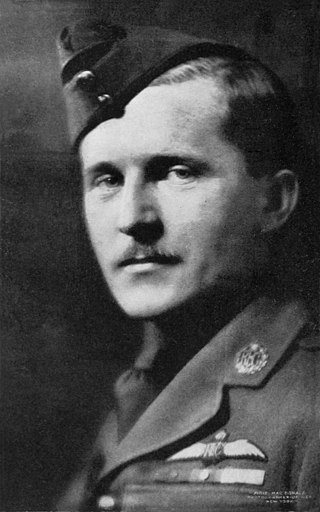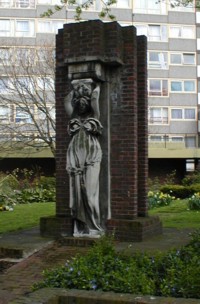
The Royal Flying Corps (RFC) was the air arm of the British Army before and during the First World War until it merged with the Royal Naval Air Service on 1 April 1918 to form the Royal Air Force. During the early part of the war, the RFC supported the British Army by artillery co-operation and photographic reconnaissance. This work gradually led RFC pilots into aerial battles with German pilots and later in the war included the strafing of enemy infantry and emplacements, the bombing of German military airfields and later the strategic bombing of German industrial and transport facilities.

Air Marshal William Avery Bishop, was a Canadian flying ace of the First World War. He was officially credited with 72 victories, making him the top Canadian and British Empire ace of the war, and also received a Victoria Cross. During the Second World War, Bishop was instrumental in setting up and promoting the British Commonwealth Air Training Plan.

Vice Admiral Richard Bell Davies, also known as Richard Bell-Davies, was a senior Royal Navy commander, naval aviator, and a First World War recipient of the Victoria Cross, the highest award for gallantry in the face of the enemy that can be awarded to British and Commonwealth forces.

Lanoe George Hawker, was a British flying ace of the First World War. Having seven credited victories, he was the third pilot to receive the Victoria Cross, the highest decoration for gallantry awarded to British and Commonwealth servicemen.

John Aidan Liddell, was a British military pilot and a recipient of the Victoria Cross, the highest award for gallantry in the face of the enemy that can be awarded to British and Commonwealth forces.

Albert Ball, was a British fighter pilot during the First World War. At the time of his death he was the United Kingdom's leading flying ace, with 44 victories, and remained its fourth-highest scorer behind Edward Mannock, James McCudden, and George McElroy.
The Robin Hood Battalion was a unit of the Volunteer Force of the British Army and Territorial Force, later the Territorial Army. The battalion served as infantry during the 1916 Easter Uprising in Dublin and then served on the Western Front during World War I. In the 1930s it re-roled as an anti-aircraft unit and served in World War II, including North-western Europe from June 1944 to May 1945.

William Leefe Robinson VC was the first British pilot to shoot down a German airship over Britain during the First World War. For this, he was awarded the Victoria Cross (VC), the highest award for gallantry in the face of the enemy that can be awarded to British and Commonwealth forces. He was the first person to be awarded the VC for action in the UK.

Air Vice Marshal Sir Frederick Hugh Sykes was a British military officer and politician.

The Royal Air Force Memorial is a military memorial on the Victoria Embankment in central London, dedicated to the memory of the casualties of the Royal Air Force in World War I. Unveiled in 1923, it became a Grade II listed structure in 1958, and was upgraded to Grade II* in 2018. It is considered to be the official memorial of the RAF and related services.
Eustace Broke Loraine was a pioneer British aviator and the first Royal Flying Corps officer to be killed in an aircraft crash.

The Malta Memorial is a war memorial monument to the 2,298 Commonwealth aircrew who lost their lives in the various Second World War air battles and engagements around the Mediterranean, whilst serving with the Commonwealth Air Forces flying from bases in Austria, Italy, Sicily, islands of the Adriatic and Mediterranean, Malta, Tunisia, Algeria, Morocco, West Africa, Yugoslavia and Gibraltar, and who have no known grave.

Henry Poole was a British architectural sculptor.

Lieutenant-Colonel Arthur William Lancelot Brewill was an architect based in Nottingham.

The Arras Flying Services Memorial Commonwealth War Graves Commission war memorial in the Faubourg d'Amiens Cemetery, Arras, France. The memorial commemorates nearly 1,000 airmen from forces of the Commonwealth who were killed on the Western Front during World War I and who have no known grave. The memorial was designed by Edwin Lutyens, sculpted by William Reid Dick and unveiled by Hugh Trenchard, 1st Viscount Trenchard, Marshal of the Royal Air Force on 31 July 1932.
Lieutenant Valentine St. Barbe Collins was a World War I British flying ace credited with ten aerial victories who served with the Royal Flying Corps and the Royal Air Force.

The Portsmouth Naval Memorial, sometimes known as Southsea Naval Memorial, is a war memorial in Portsmouth, Hampshire, England, on Southsea Common beside Clarence Esplanade, between Clarence Pier and Southsea Castle. The memorial commemorates approximately 25,000 British and Commonwealth sailors who were lost in the World Wars, around 10,000 sailors in the First World War, and 15,000 in the Second World War. The memorial features a central obelisk, with names of the dead on bronze plaques arranged around the memorial according to the year of death.

St Saviour's War Memorial is a war memorial on Borough High Street, in the former parish of Southwark St Saviour, to south of the River Thames in London. It became a Grade II listed building in 1998 and was upgraded to Grade II* in 2018.

Raymond "Chaz" Bowyer was a Royal Air Force armaments and explosives instructor who, after he retired from service, wrote and edited over forty books relating to the operations, aircraft, and men of the Royal Flying Corps, Royal Air Force, and Royal Naval Air Service. He also edited for publication the memoirs of the pilots C.P.O. Bartlett, Eric Crundall, and Gwilym H. Lewis.






















